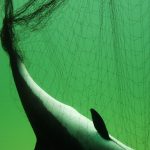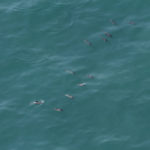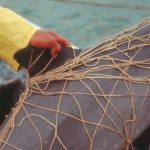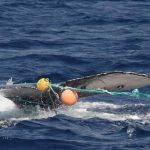Hunting removals are largely controlled, reported, and included in management schemes in NAMMCO countries. But hunting only constitutes the most tangible way marine mammals get killed. When they get entangled in fishing gears, nets and trawls, or are hooked on long lines, they drown. As marine mammals are not the target species of the fishery, this is not called catch but by-catch. Today globally, many more marine mammals are killed as by-catch versus hunting. Collision with vessels and entanglement in marine debris (including derelict fishing gears) also kill marine mammals.
By-catch

Harbour porpoise in gillnet, Poland © Krzysztof Skóra-HMS
When marine mammals get entangled in fishing gears, nets and trawls, or get hooked on long lines, they drown. As they are not the target of the fishery, this is called by-catch or incidental catch. Although it is called incidental, by-catch is largely foreseeable as it mainly happens in specific types of gear, with gillnets being the number one killer.
The global annual by-catch of marine mammals is estimated to be half a million animals, with roughly an equal number of cetaceans and pinnipeds (Read et al 2006). The World Conservation Union (IUCN) recognises by-catch in fishing gears as one of the greatest threats to the survival of cetacean populations. Furthermore, it is the single-largest cause of mortality for small cetaceans, directly endangering some populations. Yet, by-catch of marine mammals is little reported and monitored and reliable levels of by-catch only exist for a few fisheries.
In NAMMCO countries, by-catch concerns are related to harbour porpoises, grey and harbour seals in gillnet fisheries. Preliminary studies estimate the annual by-catch of harbour porpoises, harbour and grey seals of Icelandic and Norwegian gillnet fisheries in the 1000s.
The NAMMCO Scientific Working Group on By-catch aims to identify all fisheries with potential by-catch of marine mammals. Additionally, they also review and evaluate current by-catch estimates. The overall goal is to provide advice on improved data collection and the most reliable methodologies for estimating by-catch and mitigation methods. You will find meeting reports here.
Ship Strikes

Humpback whale after ship strike © NOAA
Collision with ships, or ship strike, also kill marine mammals but are often unnoticed and unreported. Ship strikes have been mostly seen as a welfare/ethical problem rather than a population-level issue (except in few specific cases). However, evidence is emerging that collisions between vessels and cetaceans may be happening more frequently than anticipated which raises concerns. In the case of endangered, endemic or geographically-isolated populations, it may pose a significant conservation threat.
Most reports of collisions between whales and vessels involve large whales, but all species can be affected. Although unnoticed and unreported, animals can be injured or killed and vessels sustain damage. There are reports of some whale watching vessels and recreational crafts having collided with whales when trying to approach too closely.
To date, ship strikes are not considered to be a significant problem in the NAMMCO countries, despite events going unnoticed and/or unreported, especially with smaller cetaceans. The development of shipping activities in the Arctic in areas essential to marine mammals may change this. In some areas impact assessments related to mining projects have predicted that ship strike related mortality (during export shipping) could become equivalent or larger than the harvest quota attributed to local communities. Ship-strike related mortality needs therefore to be monitored or estimated and included in population modelling.
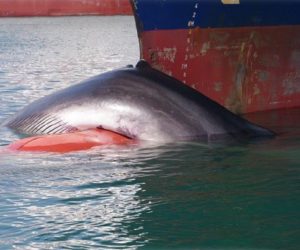
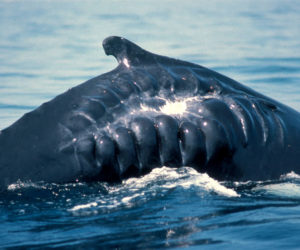
Entanglement

Brydes whale entanglement followed by starvation © NOAA
Whale entanglement, leading to laceration, infection, starvation and drowning, is globally a growing problem. Nonetheless, the extent of it remains difficult to assess. A recent report estimated that 308,000 whales and dolphins die annually due to entanglement in fishing gear, and more still in marine debris. Entanglement is a negative consequence tied to marine debris impacting marine mammals. It can be caused by abandoned, lost or discarded fishing gears (ALDFG), such as nets, ropes and monofilament lines, but also by six-pack rings and strapping bands.
Although not considered a conservation issue in NAMMCO countries currently, entanglement of large whales has been a growing problem recently. For example, humpback whales have been more present in coastal areas and fjords in Greenland, Iceland and Northern Norway.
NAMMCO established a working group in 2017 (BYCELS) that deals with animal welfare issues related to by-catch, entanglement and live strandings. Meeting reports can be found here.




